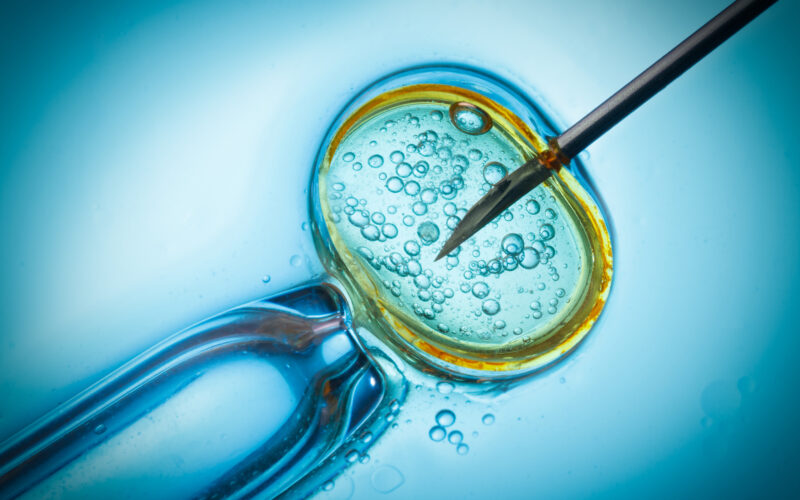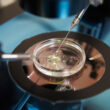Cancer is one of the leading causes of death for children, and while researchers are still striving to understand why cancer develops in children, many think that certain genes become altered while a baby is developing in the womb, giving rise to childhood cancer. Assisted reproductive technology (ART), such as in vitro fertilization (IVF), involves handling eggs or embryos outside of the body, and this process—which exposes eggs and embryos to an environment far different from the human body—is known to turn on or off certain genes in both animal studies and in human research [1]. For that reason, many studies have sought to answer whether these fertility treatments could lead to more childhood cancers.
Childhood cancer risk appears specific to ART using previously frozen embryos
Earlier this year, researchers in Europe found that babies conceived using previously frozen embryos—an IVF technique that’s becoming more popular—may have a small, but real, increased risk of developing cancer during childhood [2]. The study included nearly 8 million children from four countries: Denmark, Finland, Norway, and Sweden. The children were followed for at least nine years and grouped based on how they were conceived: naturally or with the help of ART.
Interestingly, no difference in overall childhood cancer rates was seen when children conceived naturally were compared with those conceived using ART in aggregate, but when the type of ART was considered, an important difference emerged: Children conceived using previously frozen embryos had a 65% higher risk of developing cancer during childhood compared with children conceived naturally.
(Note, however, that cancer is seen only very rarely in children—approximately 0.2% of all the children in the study developed cancer during the nine years they were followed. The absolute risk of developing cancer was 212 cases per 100,000 children conceived with frozen embryo transfer (FET), and the absolute risk of cancer was 208 cases per 100,000 children conceived naturally. Hence, the likelihood of a child being diagnosed with cancer remains incredibly low, regardless of how they were conceived.)
Differences also emerged when researchers evaluated the type of cancer. Compared with children conceived naturally, those conceived using any type of ART had an 89% increased risk of developing melanoma and epithelial tumors, and those conceived using previously frozen embryos had a 122% increased risk of developing leukemia, which is the most common cancer seen in children. (Again, however, because these cancers are rare, the chance of a child being diagnosed with any of these cancers remains low, even if ART was used).
Study confirms past research finding cancer risk with previously frozen embryos
This finding that previously frozen embryos may contribute to childhood cancer risk is not new. A study published in 2019 found the same thing, and while this year’s study, as well as a study in 2013 and another in 2014, found that ART didn’t increase childhood cancer risk, other studies have found that these methods do lead to increased risk for developing cancer as a child [3][2][4][5].
Although frustrating, the phenomenon of different studies yielding different results while studying the same issue is common in research and highlights the importance of doing multiple studies before settling on an answer. That’s why it’s also important for researchers to review and scrutinize all the studies done so far, which is what is done in a special type of study known as a meta-analysis (which combines information from multiple studies to shed light on disease and other phenomena that occur only very rarely by looking at much larger sample sizes). When done well, meta-analyses can help bring researchers closer to the truth.
Meta-analyses on childhood cancer and ART
Researchers have done several meta-analyses to better understand the issue of whether all forms of ART lead to increased childhood cancer risk and initially these evaluations showed that ART carried no such cancer risk [6]. However, the three most recent evaluations—one in 2013, another in 2018, and the most recent in 2019—have consistently shown that children conceived using ART have a slightly higher risk of developing cancer during childhood compared with children conceived naturally [7][8][9].
Is increased cancer risk due to the ART process itself or due to parental genetic factors?
Presumably, people use ART because they have struggled with infertility. So whether the elevated cancer risk is caused by ART or whatever underlying health factors contributed to the parents’ infertility remains unclear.
A 2022 study of Norwegian women published in the American Heart Association’s medical journal Hypertension examined a related question, researching whether the IVF process itself or parental factors explained a documented increased risk of maternal hypertensive (high blood pressure) disorders during pregnancy, including preeclampsia [10]. Importantly, the study included “sibling comparison,” meaning that it included women who conceived naturally in one pregnancy and then used IVF with FET in another. A total of nearly 4.5 million pregnancies were studied, and the vast majority of those were naturally conceived. 33,000 pregnancies were studied for sibling comparison, making this the largest sibling-comparison study to date on this topic. The results suggest that the IVF process itself, rather than the parents’ genetics or other medical factors, is primarily to blame for increased maternal hypertensive disorder risk. Presumably, future research using sibling comparison could clear up uncertainty about the role of the IVF process itself vs. parental health factors in increased cancer risk, too.
Childhood cancer isn’t the only risk of IVF use
Although any potential risk of cancer remains small among children conceived using ART and is a matter of continued study, experts do agree that ART procedures come with many immediate risks, such as the risk of birth defects, preterm birth, and low birth weight [11]. Given that 1 in 20 babies are now conceived using ART in the United States, and the first person conceived using IVF is only 44 years old, identifying adverse health outcomes that occur later in life is paramount, but only just now beginning to be revealed [2].
Another way to face infertility
Women and couples struggling with infertility have another option for trying to conceive. Restorative reproductive medicine (RRM) takes an approach of working cooperatively with the woman’s body and her natural cycles to address underlying hormonal or other health issues and to restore optimal health. As with ART, working with a healthcare provider trained in RRM does not guarantee a baby. But while the singular goal of IVF and other forms of ART (making a baby) can result in the commodification of the human person, RRM offers women and couples hope for conceiving that doesn’t entail thorny ethical dilemmas, nor potential maternal and child health risks associated with the IVF process.
References:
[1] Amoako, Akwasi A et al. “Epigenetic Influences During the Periconception Period and Assisted Reproduction.” Advances in experimental medicine and biology vol. 1014 (2017): 15-39. doi:10.1007/978-3-319-62414-3_2 [2] Sargisian, Nona et al. “Cancer in children born after frozen-thawed embryo transfer: A cohort study.” PLoS medicine vol. 19,9 e1004078. 1 Sep. 2022, doi:10.1371/journal.pmed.1004078 [3] Hargreave M, Jensen A, Hansen MK, et al. Association Between Fertility Treatment and Cancer Risk in Children. JAMA. 2019;322(22):2203–2210. doi:10.1001/jama.2019.18037 [4] Williams, Carrie L et al. “Cancer risk among children born after assisted conception.” The New England journal of medicine vol. 369,19 (2013): 1819-27. doi:10.1056/NEJMoa1301675 [5] Sundh, K J et al. Cancer in children and young adults born after assisted reproductive technology: a Nordic cohort study from the Committee of Nordic ART and Safety (CoNARTaS), Human Reproduction, Volume 29, Issue 9, 1 September 2014, Pages 2050–2057, https://doi.org/10.1093/humrep/deu143 [6] Raimondi, S et al. “Meta-analysis of cancer incidence in children born after assisted reproductive technologies.” British journal of cancer vol. 93,9 (2005): 1053-6. doi:10.1038/sj.bjc.6602838 [7] Hargreave, Marie et al. “Fertility treatment and childhood cancer risk: a systematic meta-analysis.” Fertility and sterility vol. 100,1 (2013): 150-61. doi:10.1016/j.fertnstert.2013.03.017 [8] Wang T, Chen L, Yang T, Wang L, Zhao L, Zhang S, Ye Z, Chen L, Zheng Z, Qin J. Cancer risk among children conceived by fertility treatment. Int J Cancer. 2019 Jun 15;144(12):3001-3013. doi: 10.1002/ijc.32062. Epub 2019 Jan 3. PMID: 30548591; PMCID: PMC6590158. [9] Chiavarini M, Ostorero A, Naldini G, Fabiani R. Cancer Risk in Children and Young Adults (Offspring) Born after Medically Assisted Reproduction: A Systematic Review and Meta-Analysis. J. 2019; 2(4):430-448. https://doi.org/10.3390/j2040028 [10] H Petersen, Sindre et al. “Risk of Hypertensive Disorders in Pregnancy After Fresh and Frozen Embryo Transfer in Assisted Reproduction: A Population-Based Cohort Study With Within-Sibship Analysis.” Hypertension (Dallas, Tex. : 1979), 10.1161/HYPERTENSIONAHA.122.19689. 26 Sep. 2022, doi:10.1161/HYPERTENSIONAHA.122.19689 [11] Qin, Jiabi et al. “Assisted reproductive technology and the risk of pregnancy-related complications and adverse pregnancy outcomes in singleton pregnancies: a meta-analysis of cohort studies.” Fertility and sterility vol. 105,1 (2016): 73-85.e1-6. doi:10.1016/j.fertnstert.2015.09.007Additional Reading:
IVF vs. Restorative Reproductive Medicine stories: What they have in common, and how they differ
Routine infertility treatments may harm mother and child, large study shows
Could chronic endometritis be causing your infertility?
The hidden costs of IVF: heartbreak, health risks, and helplessness







